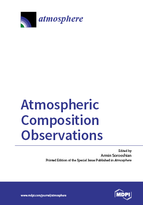Atmospheric Composition Observations
A special issue of Atmosphere (ISSN 2073-4433). This special issue belongs to the section "Air Quality".
Deadline for manuscript submissions: closed (31 August 2015) | Viewed by 105263
Special Issue Editor
2. Department of Hydrology and Atmospheric Sciences, University of Arizona, Tucson, AZ 85721, USA
Interests: surface and airborne measurements of aerosol composition, size, and water-uptake properties; aerosol-cloud-precipitation interactions; ocean-land-atmosphere interactions; cloud water and precipitation chemistry; satellite data analysis
Special Issue Information
Dear Colleagues,
The composition of the atmosphere is a critical factor in understanding the nature and magnitude of processes associated with the planet’s energy balance, clouds and precipitation, biogeochemical cycling of nutrients, and public health and welfare. A detailed understanding of trace gases, aerosol particles, and hydrometeors is challenging due to the combination of their physicochemical complexity, variable lifetimes, and spatial inhomogeneity. Recent advances in instrumentation have resulted in improved measurements and an increased understanding of atmospheric composition. Laboratory and field in-situ measurement studies have benefited from such improvements, including improved spatial and temporal resolution, the ability to sample in challenging conditions (e.g., on airborne platforms, in clouds, at widely ranging pressure and temperature conditions), and the ability to measure a wider range of chemical species, and in the case of aerosol particles, to detect smaller sizes. Remote sensing capabilities have increased in recent years, thus offering new views of atmospheric composition across broad spatiotemporal ranges.
Manuscripts related to all aspects of atmospheric observations are welcome for this Special Issue, including advances in observational techniques and scientific insights about atmospheric composition.
Prof. Dr. Armin Sorooshian
Guest Editor
Manuscript Submission Information
Manuscripts should be submitted online at www.mdpi.com by registering and logging in to this website. Once you are registered, click here to go to the submission form. Manuscripts can be submitted until the deadline. All submissions that pass pre-check are peer-reviewed. Accepted papers will be published continuously in the journal (as soon as accepted) and will be listed together on the special issue website. Research articles, review articles as well as short communications are invited. For planned papers, a title and short abstract (about 100 words) can be sent to the Editorial Office for announcement on this website.
Submitted manuscripts should not have been published previously, nor be under consideration for publication elsewhere (except conference proceedings papers). All manuscripts are thoroughly refereed through a single-blind peer-review process. A guide for authors and other relevant information for submission of manuscripts is available on the Instructions for Authors page. Atmosphere is an international peer-reviewed open access monthly journal published by MDPI.
Please visit the Instructions for Authors page before submitting a manuscript. The Article Processing Charge (APC) for publication in this open access journal is 2400 CHF (Swiss Francs). Submitted papers should be well formatted and use good English. Authors may use MDPI's English editing service prior to publication or during author revisions.
Keywords
- aerosol
- gases
- cloud processing
- aqueous chemistry
- volatile organic compounds
- biogenic
- anthropogenic
- remote sensing
- in-situ measurements






